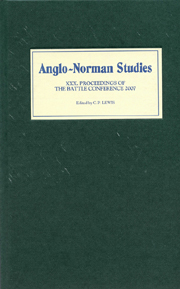Book contents
- Frontmatter
- Contents
- LIST OF ILLUSTRATIONS, MAPS, AND TABLES
- EDITOR'S PREFACE
- ABBREVIATIONS
- The Normans in Welsh History (R. Allen Brown Memorial Lecture)
- William Marshal, Lancelot, and Arthur: Chivalry and Kingship
- Grades of Ordination and Clerical Careers, c. 900–c. 1200
- Evesham J and Evesham L: Two Early Twelfth-Century Manorial Surveys
- Aspects of Church Reform in Wales, c. 1093–c. 1223
- Lay Charters and the Acta of Henry II
- Reinventing Normans as Crusaders? Ralph of Caen's Gesta Tancredi
- Kings, Lords, Charters, and the Political Culture of Twelfth-Century Wales
- Identifying the Warrior on the Pre-Heraldic Battlefield
- St Nicholas the Pilgrim and the City of Trani between Greeks and Normans, c. 1090–c. 1140
- The ‘Resurgence’ of Powys in the Late Eleventh and Early Twelfth Centuries
- Interpreter Families and Anglo-Welsh Relations in the Shropshire-Powys Marches in the Twelfth Century
- A Taste for the Antique? Henry of Blois and the Arts
The ‘Resurgence’ of Powys in the Late Eleventh and Early Twelfth Centuries
Published online by Cambridge University Press: 12 September 2012
- Frontmatter
- Contents
- LIST OF ILLUSTRATIONS, MAPS, AND TABLES
- EDITOR'S PREFACE
- ABBREVIATIONS
- The Normans in Welsh History (R. Allen Brown Memorial Lecture)
- William Marshal, Lancelot, and Arthur: Chivalry and Kingship
- Grades of Ordination and Clerical Careers, c. 900–c. 1200
- Evesham J and Evesham L: Two Early Twelfth-Century Manorial Surveys
- Aspects of Church Reform in Wales, c. 1093–c. 1223
- Lay Charters and the Acta of Henry II
- Reinventing Normans as Crusaders? Ralph of Caen's Gesta Tancredi
- Kings, Lords, Charters, and the Political Culture of Twelfth-Century Wales
- Identifying the Warrior on the Pre-Heraldic Battlefield
- St Nicholas the Pilgrim and the City of Trani between Greeks and Normans, c. 1090–c. 1140
- The ‘Resurgence’ of Powys in the Late Eleventh and Early Twelfth Centuries
- Interpreter Families and Anglo-Welsh Relations in the Shropshire-Powys Marches in the Twelfth Century
- A Taste for the Antique? Henry of Blois and the Arts
Summary
The early medieval kingdom of Powys, which had by tradition extended over much of central and eastern Wales, had effectively ceased to exist in the course of the ninth century. Parts of the kingdom had fallen to English incursions, while much of the remainder appears to have been absorbed into Gwynedd. For some two hundred years Powys appears to have existed as a region rather than as a polity. Mid-twelfth-century sources, however, reveal a very different situation. A vigorous, though more restricted, realm of Powys had re-emerged, ruled by a dynasty that traced its origins to the formidable and talented Bleddyn ap Cynfyn who had died in 1075. According to the poet Gwalchmai, Bleddyn's grandson Madog ap Maredudd had ruled a kingdom that extended from the summit of Pumlumon to the gates of Chester, and from Bangor (on Dee) to the border of Meirionnydd. His realm was very similarly described in the later Dream of Rhonabwy. The twelfth-century Latin Life of Gruffudd ap Cynan refers to a king of Powys in the late 1070s and to princes of Powys in the early years of the twelfth century, while Meilir Brydydd's elegy for Gruffudd ap Cynan (1137) refers to ‘kings of Powys’ at the battle of Mynydd Carn in 1081. It is noteworthy that all of these designations are retrospective. In this resurgence of a kingdom of Powys it seems at first sight that the late eleventh and very early twelfth centuries were crucial.
- Type
- Chapter
- Information
- Anglo-Norman Studies 30Proceedings of the Battle Conference 2007, pp. 182 - 195Publisher: Boydell & BrewerPrint publication year: 2008



